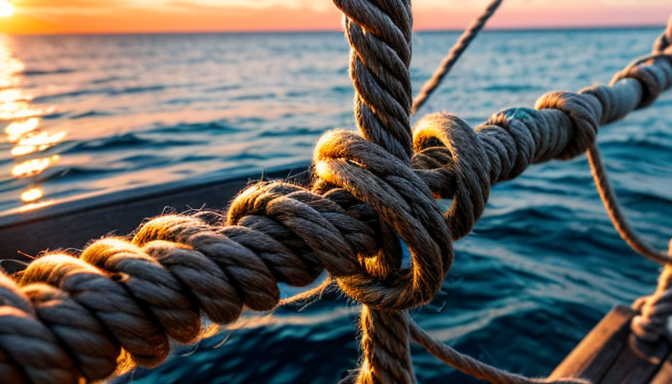Unlocking the Secrets of Seamanship: A Beginner’s Guide
Welcome aboard! If you’ve ever gazed longingly at the horizon, dreaming of adventure on the open water, you’re in for a treat. This guide aims to introduce newcomers to seamanship, covering essential skills, safety practices, and the joy of navigating the waters confidently. Imagine the thrill of hoisting the sails, feeling the wind in your hair, and knowing you have the skills to handle whatever the sea throws your way. Isn’t that exhilarating?
Understanding the fundamental skills required for seamanship is crucial for beginners. This section outlines key abilities that every sailor should master. First up is knot tying, which is not just a party trick but a vital skill. Think of knots as the lifelines of your sailing experience; they secure your sails, anchor your boat, and keep everything in place. Next, let’s talk about navigation. It’s like reading a treasure map! Familiarize yourself with the basics of using a compass and charts, and you’ll soon find that the world is your oyster. Lastly, boat handling is essential. Mastering how to steer and maneuver your vessel will give you the confidence to tackle any situation on the water.
Safety is paramount in seamanship. You wouldn’t jump into a car without a seatbelt, right? The same goes for sailing. Always wear a life jacket, and ensure your boat is equipped with essential safety gear, such as flares, a first aid kit, and a fire extinguisher. Know the emergency procedures—because when the unexpected happens, it’s better to be prepared than panicked. Remember, the sea can be unpredictable, but with the right knowledge and precautions, you can navigate it like a pro!
Essential Skills for New Sailors
Embarking on your sailing journey is like stepping into a vast, uncharted world where the horizon meets endless possibilities. To navigate these waters confidently, mastering essential skills is crucial for every aspiring sailor. First and foremost, knot tying is an art that every sailor must embrace. Think of knots as the lifelines of your journey; they secure your sails, anchor your boat, and keep everything in place. From the simple bowline to the versatile clove hitch, each knot serves a unique purpose and can be a lifesaver in tricky situations.
Next up is navigation. Understanding the basics of navigation is akin to reading a treasure map. You’ll need to familiarize yourself with nautical charts, compass readings, and GPS technology. Knowing how to plot a course and read the wind can make all the difference between a smooth sail and a frustrating detour. Remember, every sailor was once a beginner, so don’t hesitate to ask for guidance!
Equally important is boat handling. This skill involves understanding your vessel’s capabilities and how to maneuver it in various conditions. Practice makes perfect, so spend time getting to know your boat. Whether it’s tacking, jibing, or docking, each maneuver requires finesse and confidence. As you develop these skills, you’ll find that sailing transforms from a daunting challenge into an exhilarating adventure.

Safety Practices on the Water
When it comes to sailing, safety should always be your top priority. Imagine you’re on a beautiful day out on the water, the sun shining and the wind filling your sails. But wait—what if something unexpected happens? That’s why understanding the essential safety practices is crucial for every sailor, especially beginners.
First and foremost, familiarize yourself with the basic safety equipment required on board. This includes life jackets, flares, and a first aid kit. Each piece of equipment plays a vital role in ensuring your safety and the safety of your crew. For instance, did you know that wearing a life jacket can increase your chances of survival by up to 90%? Always make sure everyone on board is wearing one, and that they fit properly.
Next, you’ll want to learn some vital emergency procedures. This could be anything from knowing how to handle a man overboard situation to understanding the protocol during severe weather. Preparation is key. Consider practicing these drills regularly, so they become second nature. You wouldn’t want to be caught off guard in a critical moment!
Lastly, always keep an eye on the weather. Conditions can change rapidly out on the water, and being aware of weather patterns can make all the difference. As the saying goes, “It’s better to be safe than sorry.” So before you set sail, make sure to check the forecast and plan your trip accordingly.
By mastering these safety practices, you’ll not only enhance your seamanship skills but also ensure that your sailing adventures are enjoyable and safe. Ready to set sail? Let’s go!
Frequently Asked Questions
- What are the essential skills needed for beginners in seamanship?
As a newbie sailor, you’ll want to focus on mastering a few key skills. These include knot tying, which is crucial for securing lines, navigation to help you find your way, and boat handling to maneuver your vessel confidently. Think of these skills as the building blocks of your sailing journey!
- How can I ensure safety while sailing?
Safety on the water is non-negotiable! Always wear a life jacket, check your emergency equipment before setting sail, and familiarize yourself with basic emergency procedures. It’s like having a safety net—better to have it and not need it than to need it and not have it!
- What should I do in case of an emergency at sea?
If you find yourself in an emergency, stay calm and assess the situation. Use your radio to call for help, follow your emergency procedures, and ensure everyone on board is safe. Remember, staying composed is key—just like navigating through stormy waters!






